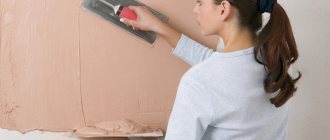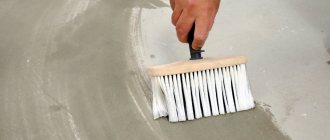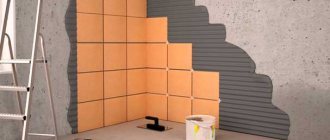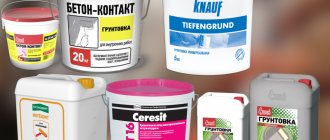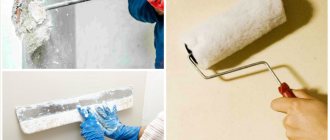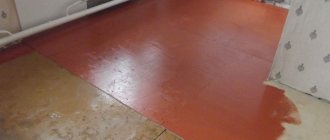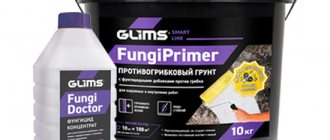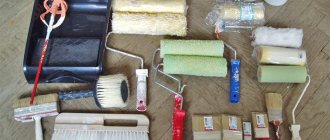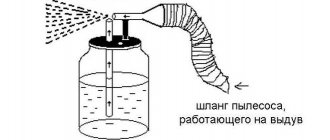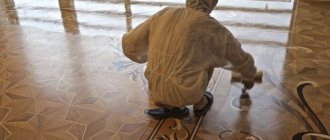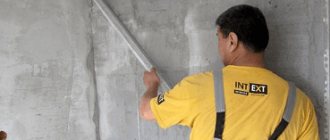Primer and toxicity
Not all types of primers are intended for indoor use. This is due to the chemical composition of some products. Therefore, before purchasing, it is better to find out how safe the primer is for human health. This is especially important for families with small children.
Application technology
Any wood must be cleaned of dirt and dust, and, if necessary, the top layer must be sanded. Then you need to prepare the primer composition. It needs to be stirred, since standing for a long time may cause a small but solid sediment to form at the bottom of the jar.
The more uniform the primer is, the better the application result will be.
Remove dust from the surface with a damp sponge, and remove greasy stains with a soap solution. Minor defects are repaired with putty, and old paintwork is completely removed.
Any of the following tools will be suitable for application.
It is better to prime at positive temperatures and low air humidity. Each applied layer is given sufficient time to dry.
The application technology is the same for all types of wood, but the preparation is different.
Over old paint
If you plan to prime old wood that has already been painted and the type of paint matches the type of primer, there is no need to completely strip off the old paint.
Alkyd, oil paint, nitro enamel must be removed with sandpaper. It is important to ensure the roughness of the top layer of the base. If there are areas with loose wood fibers, they need to be removed with a spatula and sanded.
If the colors of the old and new paint do not match, a separating layer of primer must be applied between them. The dye must be applied after the primer has completely dried. If the new type of finish differs from the old one in properties, for example, it was alkyd paint, but is covered with oil paint, you need to heat the painted surface with a hair dryer. Afterwards, the remnants of the old paint are removed with a metal spatula. If there are still traces of the old dye, they need to be wiped off with a solvent.
Next, the surface is treated with an antiseptic and a finishing primer for painting. An antiseptic can be either a separate additive to the soil or be part of a universal primer.
On fresh wood
Fresh wood is sanded and scraped. Then the cracks and minor defects are sealed with acrylic putty. It does not crack when the size of the tree changes due to its high elasticity.
You need to remove any remaining dust and dirt from the surface, and then start priming. The acrylic mixture will need to be applied in several layers.
Why do you need a primer?
In addition to thoroughly cleaning and degreasing the wood, it is also worth using primers. What to look for when choosing them? The use of this type of product is very important.
Using a primer, you can regulate the absorbency of painted surfaces. This will significantly reduce paint use.
Applying a primer to wood also helps strengthen the substrate, make it resistant to moisture and improve its adhesion, which will affect the effectiveness of the final product.
Useful tips
Air humidity should be low. This will allow the material to dry faster. The air temperature should be from 5 to 30 degrees above zero. The higher it is, the faster the primer will dry. Therefore, you should do this in the morning or evening.
- The first coat of primer should be thin enough to fill all pores and cracks.
- If the wooden tiles are created by pressing chips, then 4 layers of primer should be applied.
- The quality of material impregnation depends on the number of primer layers.
- To apply a new layer, the old one must be completely dry.
- Soil doesn't have to be expensive.
- The primer must be water-repellent. This applies not only to the painting process. The shelf life of the tree itself and how precipitation will affect it will depend on this. It is worth noting that alkyd primer is not afraid of moisture.
- Time. A high-quality primer always dries quickly and is easy to apply.
Old paint
Old paint can be removed by heating it with a hair dryer. It can be removed with a spatula. And using acetone, you can get rid of paint residues. If the new paint is the same type as the old one, then it can be applied without getting rid of the old layer. This does not apply to cases where the paint has begun to deteriorate or peel. This is exactly how wood should be primed. Even if the tree does not need treatment or protection, a primer coat will help save money.
Source
Where to use primer
When to use primer? Of course, when painting wooden surfaces for the first time, as well as when repairing old furniture or natural wood floors. The primer can also be used for wood materials such as MDF boards.
Before priming
In order for the wood, first coated with a primer and then varnish, to look impressive and last a long time, it must be properly prepared and stocked with the necessary tools.
Tools you will need:
- a set of abrasive paper (“sandpaper”) of different grain sizes;
- small rubber plate;
- a rectangular block, the size of which depends on the surface being processed.
Having stocked up on tools, you can begin the preparatory work. All wooden surfaces are treated with sandpaper, smoothly moving it along the wood fibers. It is necessary to gradually change the grain size from coarse to finer. To process large areas (such as parquet, panels), it is more convenient to wrap a bar of the required size with abrasive paper; for smaller parts (furniture elements), it is more convenient to wrap a rubber plate.
Tip: It is most convenient to collect fine dust and wood shavings with a vacuum cleaner. After thoroughly processing and cleaning the surface, you can begin to apply the primer layer.
Types of primers for wood
There are many types of primer paints available in the market, which differ mainly in their functional parameters.
They can also be used on certain surfaces and in certain conditions, so it is worth considering carefully which type is preferable.
You can highlight products such as:
- Acrylic primer for wood - acrylic primer is a water-based product that is characterized primarily by the formation of a coating with very good adhesion, thanks to which paints adhere well to the surface. This product is resistant to abrasion, cleaning, as well as water and ultraviolet rays. When buying acrylic primers, you should choose products that contain additional substances that protect against mold and mildew. They are used before applying stains, paints and varnishes;
- Flaxseed varnish is a product obtained by thickening linseed oil. To speed up drying, additional ingredients are also used, that is, driers (for example, rosin salts). The varnish is characterized by deep penetration into the wooden surface. Using the product allows you to create a waterproof coating;
- Oil-phthalic primer - should not be used on surfaces that have not previously been primed. This paint is used primarily to further increase surface adhesion and mask various types of stains;
- Latex Primer Paint – The biggest benefit of paint is that it is flexible and makes wood surfaces more resistant to peeling and cracking. However, problems can arise in a situation where there are strong stains on the wood or wood material - latex products cannot always disguise them, so the top coating should cover well;
- Alkyd primer paint – used primarily under alkyd oil and latex paints. The limitation for application is that it must be applied in a thin layer. Why? It dries primarily with oxygen, which would be much more difficult with a thicker coating. Alkyd primers are characterized by good fluidity (due to which their use can be dosed), as well as resistance to weather conditions;
- Primers and impregnators – these products combine the properties of standard primers and impregnations. Thanks to this, they prepare wooden surfaces for painting (including by giving them adhesion), and also protect them from insects, the development of mold and mildew, as well as the negative effects of water, high and low temperatures. All this means that primers and impregnations should be used primarily for wooden elements that will be located outside the building;
- Styrene primer is a means of protecting wood from rotting associated with the destruction of the surface as a result of the decomposition of plant and animal remains. Primers of this type are used primarily before painting with phthalic, alkyd and non-phthalic paints;
- Wood primer comes in many varieties, so it should be selected depending on the type of wood and the use of painted surfaces. Its effect is primarily related to color protection - thanks to the use of varnish, it remains intense for a long time. Because primer fills the pores in the wood, it protects the paint or topcoat from peeling and sagging. In addition, it improves the grip of the wooden surface. Mainly used for wooden floors.
Criterias of choice
When choosing a primer, take into account its main characteristics:
- transparency;
- availability of antiseptics;
- surface to be covered;
- drying time;
- ease of application;
- choice of finishing coating.
A colorless primer allows you to highlight the beautiful texture of wood. After this treatment, the surface is varnished or another colorless finish is applied. Wood is exposed to insects and can develop mold and harmful microorganisms. By applying a coat of primer, the finish gains the ability to repel pests.
What to prime the wood with before painting directly depends on the location of the finish. Wood is widely used to decorate interior walls and building facades.
The type of wood primer for exterior use is selected with the property of repelling moisture. In interior spaces, choose a coating without harmful components.
At high humidity, the period required for the material to dry almost doubles. Acrylic primer is used outdoors because it dries faster. If you need to treat wood in the heat, it is better to prime the surface in the morning or during the day.
It is best if the coating is applied in one layer. Alkyd primer meets this requirement. Other types of materials usually require at least two coats.
If the surface is planned to be painted, then white types of material are selected. Does the design involve preserving the wood grain? Prepare priming surfaces thoroughly.
White and transparent primers
In addition to the division of primers presented above, you also need to consider whether a clear or white coating is required.
White primer for wood creates a matte finish that works under covering paints, and also when there is a need to mask all types of defects and irregularities in wood.
Preparing for painting
Priming is preceded by a thorough preparatory stage.
Preparation and priming steps:
If the material is painted, the old coating is removed. The exception is colorants of the same type as the new coating. That is, acrylic paint can be used to cover old paint if it is made on the basis of acrylic. But for this it is important that the old layer is durable and does not delaminate.
Degreasing wood
For degreasing, use turpentine, acetone or universal removers. The first two products are applied with a rag 3-4 times. The resin pockets are filled with the selected solvent and blotted with a swab. Removers are used when it is necessary to remove old coating.
- Application of antiseptic.
To prevent the tree from rotting over time and becoming an abode of woodworms, the material is coated with an antiseptic primer once using a roller or a wide construction brush.
Often such mixtures contain flame retardant additives, which increase the fire resistance of the coating.
At this stage, they get rid of cracks and minor defects, hide seams and recesses from cutting into self-tapping screws, so that the varnish and other decorative means adhere better. When painting, it is recommended to give preference to acrylic products, which are more elastic. The composition is applied in two stages, since the acrylic product will shrink after drying.
If you plan to apply a transparent varnish to the base, then for puttying it is better to create your own composition from sawdust and PVA. This product is transparent and will not shrink after drying.
Homemade putty
- Grinding.
The procedure is performed after puttying. Movement is allowed only in the direction of growth of wood fibers. To do this, use sandpaper or a belt sander.
- Treatment with penetrating primer.
This layer is designed to increase the strength of the material, increase its adhesive properties and reduce paint consumption.
Photo of the best primer for wood
Degreasing surfaces
The paint can usually indicates which degreasing and paint thinner should be used for a particular surface. You can use universal products such as white spirit, gasoline or acetone. When working with plastic, choose soft, gentle products, for example, Piton or APP WK900.
